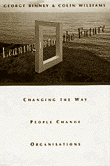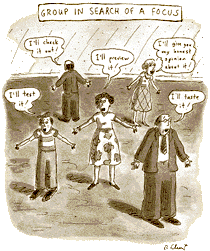"Leaning into the Future: Changing the Way People Change Organizations" by George Binney and Colin Williams
Leaning into the Future: Changing the Way People Change Organizations by George Binney and Colin Williams (175 pages, Nicholas Brealey Publishing Ltd., 1995)
(originally published by Booz & Company)
 The title of Charles Handy's 1994 book, The Empty Raincoat, was changed for the American market. It became The Age of Paradox. Americans, so the publishers thought, would be uncomfortable with a title derived from a sculpture in Minneapolis and at ease with the notion of a business world beset by paradoxes. Europeans, it was decided, were at home with sculptures and uneasy with paradox.
The title of Charles Handy's 1994 book, The Empty Raincoat, was changed for the American market. It became The Age of Paradox. Americans, so the publishers thought, would be uncomfortable with a title derived from a sculpture in Minneapolis and at ease with the notion of a business world beset by paradoxes. Europeans, it was decided, were at home with sculptures and uneasy with paradox.
Paradoxes are a recent discovery in the closeted world of management thinking. Previously, thinkers were content to settle for opposites — Theory X and Theory Y; centralization and decentralization; control and chaos; simplicity and complexity. Now, management literature abounds with paradoxes as commentators examine a new bewildering world where once mutually exclusive ideas and approaches are combined.
Typical of the trend is Tom Peters's recent work, which features example after example of organizations that are free-flowing idea factories but that do have definite and sometimes ornately defined structures. Asea Brown Boveri prospers with a matrix structure that could be described as dynamically fuzzy. Its managers admit to being confused by the matrix, yet they live by it and within it. The theory is that the tension of traditional opposites harnesses energy.
There are paradoxes at every turn, but that does not make it any easier to come to terms with or to manage them. They are still there, as unfathomable and unbridgeable as ever. Indeed, skeptics might suggest that books charting the paradoxical nature of the executive world are simply avoiding the issue. If you can't reach a definitive or rational conclusion, dress your ideas up as far-reaching paradoxes. In some cases, this is unquestionably so.
It is, therefore, with some disquiet that you find that paradoxes form the cornerstone of Leaning Into the Future, by two British academics and consultants, George Binney and Colin Williams. "Leaning into the future," they say, "is a potent and practical way of working with change which combines apparent opposites: leading and learning; being forthright and listening; giving direction and allowing autonomy."
Leading and learning is the central paradox identified by Mr. Binney and Mr. Williams. The leaders they celebrate regard assertiveness and listening as two sides of the same coin. You can have your cake and eat it, they write, since these leaders "are not perturbed by the tension between leading and learning but work with it and exploit it. Just as a sailor tacking into the wind steers first one way, then another, in order to reach an objective, so individuals who handle change effectively steer a winding course between leading and learning, first emphasizing one objective, then the other. They do so in such a way that their success in leading encourages learning and their effectiveness in learning fosters leading. This outstanding combination is the basis of their success."
Mr. Binney's and Mr. Williams's point is that, discomfiting though they may be, paradoxes are the only available and reasonable explanation of the issues and challenges facing executives now and in the future. Paradoxes are not a convenient shorthand when you don't know the answers, but valid explanations in a world without answers.
The authors are at their most vehement — and accurate — when dismissing the continuing propensity for managers to leap onto the nearest available bandwagon. The result, they say, is a lack of direction and executives in touch with the gurus, but woefully out of touch with reality. Fashion-conscious organizations end up attempting to implement every bright idea their senior executives have recently come across — Mr. Binney and Mr. Williams report that one company they worked with had 19 initiatives under way simultaneously.
Nowhere is this more obvious than in the ways in which companies attempt to change themselves. Managing change, the authors say, has tended to embrace either of two extremes.
In the first, the organization is regarded as a machine. There is a belief that "change needs to be driven" and that "change can be planned and predicted." All the mechanically minded chief executive needs to do is to frame a suitably pithy mission statement that seeks to transplant past success into the future. Most corporate missions, Mr. Binney and Mr. Williams say, would be better described as hallucinations.
The second perception of change regards organizations as living systems. Here, the talk is of "reinforcing emerging patterns" of working with forces that already exist.
Both perspectives, the authors say, are flawed. "They remain metaphors," they write. "They are not the whole truth, simply one way of understanding reality. A way of seeing is also a way of not seeing." If true change is to be achieved, opposite approaches need to be distilled together. The mechanistic faith in driving through change and the organic approach of "releasing" change must be transformed into "working with the grain." The extremes of "doing" and "reflecting" must be reincarnated as "learning while doing." Two extremes united become a paradox.
The authors reserve their most passionate criticism for re-engineering. "Evangelical zeal sometimes gives way to hyperbole," they write, going on to quote Michael Hammer and James Champy's claim that re-engineering is concerned with "rejecting conventional wisdom and received assumptions of the past ... it is about reversing the Industrial Revolution ... tradition counts for nothing. Re-engineering is a new beginning." Mr. Williams and Mr. Binney file this neatly under hyperbole: "The last time someone used language like this was Chairman Mao in the Cultural Revolution. Under the motto 'Destroy to build,' he too insisted on sweeping away the past."
The past may be another country where people did things differently, but it cannot be so conveniently swept away — something Mao discovered and Mr. Champy and Mr. Hammer are also having to come to terms with as companies struggle with the full practical ramifications of their particular manifesto.
Corporate Maoism is tempting — as the continuing passion for downsizing demonstrates. It is clear-cut, belonging to the world of incompatible extremes rather than paradoxes. How then can the past be built on, rather than wantonly destroyed? It is here that the world of paradoxes comes unstuck. It eschews easy answers, but is then forced back to perennial words of wisdom. Mr. Williams and Mr. Binney contend that companies must "try to understand in depth why they have been successful and ... try to do more of it."
Undoubtedly, this is a simplistic notion. But, for all the talk of paradoxes, it is as viable an answer as any. While book after book revels in the contemporary complexity of management, few manage to wallow in its simplicity for very long without muddying the waters. Companies are very poor at understanding exactly why they have been successful. (Corporate success becomes intertwined with individual leadership — look at G.E. and Jack Welch, Gates at Microsoft, the Watsons at I.B.M., Sloan at G.M., Iacocca at Chrysler.)
In contrast, corporations are highly accomplished at replicating their past behavior. More of the same is addictive, especially when it has a track record.
As an example of living in the new world of paradoxes, Mr. Williams and Mr. Binney point to the approach taken by Nissan, the Japanese car manufacturer, when it opened a plant in Britain.
"Despite their vastly superior record in running car businesses, the Japanese managers at Nissan did not come to the U.K. to tell the British managers how to do it," they observe. "The Japanese management questioned, challenged and, at times, drove the British managers wild with their examination of the accepted way of doing things and their attention to detail; but they made it plain from the start that the decisions and the responsibility for running a British plant with British workers rested with British management." The plant has been highly successful and the British managers talked to by Mr. Williams and Mr. Binney have been transformed — they are "softly spoken, questioning, listening, not status conscious and more likely to say 'we' than 'I.' "
 This appears to be corporate nirvana. Aggressive underachievers have become paragons of paradox. The trouble is, that virtue may well be skin-deep. Judith Thompson and Robert Rehder of the University of New Mexico have recently been scathing in their criticism of the gap between Nissan's much vaunted working practices and reality. Nissan trumpets flexibility, quality and teamwork, but the reality, according to Ms. Thompson and Mr. Rehder, is different. There is, for example, no mechanism for challenging company views. There is also "a high level of fear among employees" and "an environment of intimidation and high stress." The success of managing paradox in reality is clouded by yet more paradoxes — the empowered are voiceless; teamworking is shadowed by individual fear.
This appears to be corporate nirvana. Aggressive underachievers have become paragons of paradox. The trouble is, that virtue may well be skin-deep. Judith Thompson and Robert Rehder of the University of New Mexico have recently been scathing in their criticism of the gap between Nissan's much vaunted working practices and reality. Nissan trumpets flexibility, quality and teamwork, but the reality, according to Ms. Thompson and Mr. Rehder, is different. There is, for example, no mechanism for challenging company views. There is also "a high level of fear among employees" and "an environment of intimidation and high stress." The success of managing paradox in reality is clouded by yet more paradoxes — the empowered are voiceless; teamworking is shadowed by individual fear.
None of this makes managing, accepting or living with paradoxes a simple matter.
It can appear that shrugging your shoulders and accepting the paradoxical nature of business life is an essential ingredient for success and sanity. Yet managers, members of a profession oriented around tasks and action, may fear that they will be reduced to impotence. Mr. Binney and Mr. Williams contend that this is not the case. Instead, they say, all that managers have to lose is their belief in the necessity for control.
But for the executives who read this tautly argued book, that is probably the most disturbing and far-reaching paradox of all. ![]()
| Authors
Stuart Crainer (stuart.crainer@suntopmedia.com) is a U.K.-based business journalist and a contributing editor to strategy+business. Mr. Crainer is author and editor of numerous management books, including the Financial Times Handbook of Management (Financial Times Prentice Hall, 2001) and The Management Century: A Critical Review of 20th Century Thought and Practice (Jossey-Bass, 2000). |

